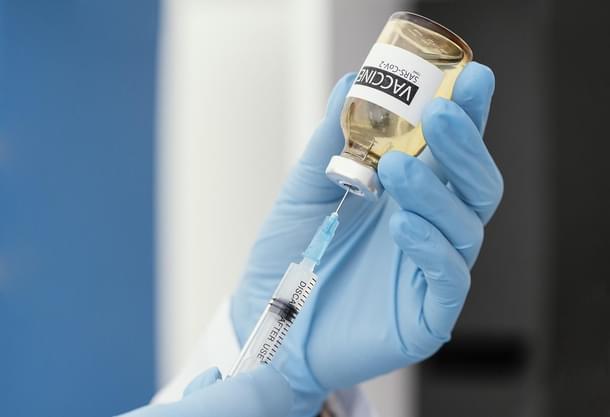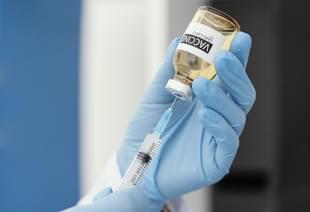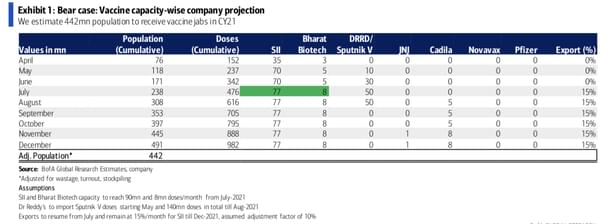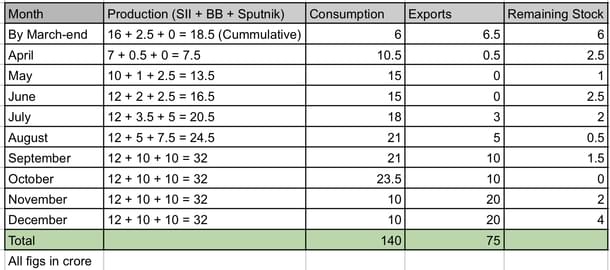Science
Bullish Scenario For Vaccine Rollout: How India Might Achieve Herd Immunity By Dussehra
Swarajya Staff
Apr 20, 2021, 06:40 PM | Updated 06:39 PM IST
Save & read from anywhere!
Bookmark stories for easy access on any device or the Swarajya app.


As Israel lifted mandatory outdoor mask protocol on Sunday (18 April) and opened schools fully for the first time since September, citizens heaved a sigh of relief. Israel managed to achieve this feat by quickly cutting a deal with Pfizer to supply over eight million shots (enough to vaccinate more than half of the country’s population) at a premium of 40 per cent compared to what the US government or the European Union were paying to the vaccine manufacturer.
Professor Eran Segal of the Weizmann Institute of Science posted on Twitter the fruits of vaccinating 56 per cent of your population. "Since mid-Jan. peak: 98% fewer cases, 93% fewer critically ill, 87% fewer deaths, 85% of 16 y/o & above vaccinated/infected. Life is close to pre-covid," he said.
Among large countries, only the United States could be said to have achieved a moderate level of success as 25 per cent of the population is now fully vaccinated. The same figure for the UK is 15 per cent.
India has managed to give both jabs to only 1.2 per cent of its population. It faces the biggest challenge in the world (by far) as far as vaccination is concerned. Despite having massive vaccine production capabilities domestically, India will take a few months extra than countries like the US which may achieve herd immunity by July end at current pace of vaccination. However, the time required will be much shorter than what people think.
As per a report prepared by analysts at brokerage firm BofA Securities, India could vaccinate 34 per cent, 40 per cent and 48 per cent of India’s population by this year’s end in bear, middle and bull scenarios respectively.
The analysts believe that high demand for vaccines is going to drive more approvals from the government. Already, Russia’s Sputnik V has received emergency use authorisation along with all foreign vaccines granted emergency approval for restricted use by USFDA, EMA, UK MHRA, PMDA Japan or those listed in WHO's Emergency Use Listing.
Single shot vaccine by Johnson and Johnson (J&J) is likely to be approved in a matter of days as per India’s Principal Scientific Adviser and co-chair of the Covid-19 vaccine task force K Vijay Raghavan.
Today (20 April), the company has applied with the Drugs Controller General of India (DCGI) for an approval to conduct a local bridging study.
As per the revised norms, bridging trials can continue in parallel with the vaccine rollout in the country.
Currently, the J&J vaccine is on hold everywhere due to reported cases of blood clots among six recipients out of more than six million. By this week’s end, we could get clarity on J&J’s future. Most likely, its vaccination will be given green signal with some terms and conditions.
Below are the bear, middle and bull scenarios estimated by BofA Securities’ research:



As of 19 April, India has administered 12.7 crore doses. By April-end, this number should comfortably reach 16 crore assuming a conservative rate of 30 lakh vaccinations per day.
In the bull case scenario for India, we should be able to vaccinate over 62 crore people by end of this year. This is calculated after assuming wastage of 10 per cent flat. As of now, only Tamil Nadu and Haryana have recorded wastage above and close to double digit. All major states are doing good.
In fact, till 11 April, national percentage for wastage was below 5 per cent (44 lakh wasted out of 10 crore utilised doses).
Wastage should be understood as a proxy for vaccine hesitancy rather than administrative inefficiency. With vaccination open to those above 18 from 1 May, there is high chance that we will see far fewer wastage as opened doses in vials don’t go waste for want of recipients.
At the very least, it won’t be worse than what it is now. Straightaway, we can add 6-7 crore doses to the total cumulative stockpile in the bear case scenario of BofA Securities (as it assumes a wastage of over 13 crore doses in total).
Another conservative estimate that BofA research has made in its bull case scenario is the production capacity of Bharat Biotech for manufacturing Covaxin. This may be due to not accounting for various actions taken by the government this week to ramp up the production of India’s first completely indigenous vaccine.
An advance credit of Rs 1,500 crore to the company was cleared just yesterday. On 16 April, the press release by the government declared that "the current production capacity of indigenously developed Covaxin vaccine will be doubled by May-June 2021 and then increased nearly 6-7 fold by July-August 2021 i.e increasing the production from 1 crore vaccine doses in April, 2021 to 6-7 crore vaccine dose/month in July- August. It is expected to reach nearly 10 crore doses per month by Sep 2021."
The only liberty one can accuse BofA Securities of taking is for Sputnik V import by Dr Reddy’s.
In its bearish case, BofA analysts assume import of 14 crore doses by August while in their bull case scenario, assumption is that Dr Reddy’s will get all the 25 crore doses it has contracted to receive from Russian Direct Investment Fund (RDIF) by August itself.
However, BofA doesn’t account for local, large-scale manufacturing of Sputnik V which will start in earnest by July.
Indian manufacturers Gland Pharma (25 crore), Strides Arcolab's Stellis (20 crore), Virchow Biotech (20 crore), Panacea Biotech and Hetero Drugs (10 crore each) alone will deliver 85 crore doses, half of which could come in 2021 alone. That’s almost four times the overestimation made by BofA in imports by Dr Reddy’s till August.
Based on all these, here is a more bullish case on vaccine arithmetic for India.

Assumptions for this bullish scenario are as follows: Like BofA analysts, SII’s production of vaccines is estimated to rise to 12 crore a month from July. Since this is maximum capacity SII can operate at, Covavax production is also included in the 12 crore figure.
This scenario assumes that India gets 2.5 crore doses of Sputnik as import in May, June and July which increases to 5 crore doses a month from August.
Additionally, local manufacturing of Sputnik is assumed to enter market in August with 2.5 crore doses and increased to 5 crore doses from September. This is conservative estimate as supply from local production may come in July itself.
Also, it is estimated that local companies will manufacture 40 crore doses of Sputnik V this year but at 5 crore doses a month, this scenario assumes that they will be able to produce only 30 crore. Another conservative estimate.
From our scenario, it’s highly certain that India will be reaching herd immunity by Dussehra/Diwali. It would have vaccinated around 62 crore people above the age of 18. That’s almost 80 per cent of the total eligible population.
Of course, we are assuming that such a high percentage of population will be willing to get a jab. The government might have to use carrot and stick policy to ensure that most eligible people get vaccinated.
By September, we would likely not need SII supplies and those can be exported completely to meet various international commitments. From October onwards, India can be aggressive again in vaccine diplomacy and divert more than two-third of local production abroad.
Here, one hasn’t even taken into account other vaccine candidates which may get approval such as J&J, Zydus Cadila, Pfizer, Moderna, etc. J&J’s approval will quicken the pace of vaccination as it’s a single shot vaccine. In such a scenario, we are looking at reaching herd immunity much ahead of Diwali.
It means, the difference between India and most developed countries will be negligible in terms of time taken to vaccinate majority of the population. That would be one big achievement.





